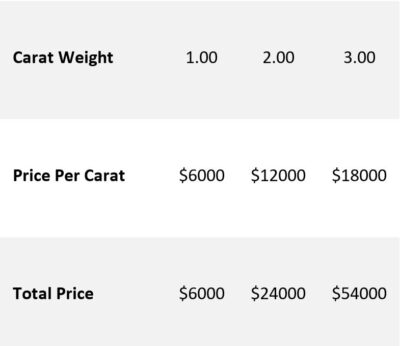Diamonds are sold by the carat (shown as ct.), which as a matter of fact is a unit of weight, even though most think of it terms of size. The word “carat” originates from the “carob” seed, the historical unit of measure for diamond traders. Today, a carat is equal to exactly 0.2 grams (about the weight of a paper clip). Two diamonds that have equal carat weight can have very different costs based due to factors (such as cut, color, and clarity). If the customer’s heart is set on a particular size of a diamond, then carat weight will probably be the most important factor in your search until the desired size is attained. After you found your desired size , other criteria will take on more importance, most women can tell you the carat weight and shape of their ideal diamond, and most men can tell you the price. As the carat size of a diamond increases, subsequently the diamond’s price increases ,Why? Because the larger the diamond, the more rare it is. Fewer than one in one million mined rough stones are large enough to produce a finished 1 carat diamond. So, as carat weight increases, you will typically pay more not only in total, but on a price-per-carat basis as well. The table below shows the typical relationship between diamonds of equal quality and increasing carat weights:

Even though the price of a diamond increases exceptionally with the carat weight, the actual size does not. The table below illustrates the typical size relationship between diamonds of increasing carat weights. Note that when carat weight triples (from 1 to 3 carats), perceived size (represented in the images below) roughly triples as well, however the diameter increases only 45% (from 6.50 to 9.40), and crown area (the surface area visible when the diamond is set) a bit more than doubles.
This is important to keep in mind when reviewing diamonds of any shape; the increase in diameter will create a larger increase in surface (crown) area and overall perceived size. While the third diamond above has a roughly 50% greater diameter than the first, it certainly appears more than 50% larger.
Size and Carat weight comparison, when viewing diamonds at A Star Diamonds, check the measurements listed for each diamond to understand its size. The length and width will tell you exactly how large the diamond will appear when viewed from above.
Two diamonds that are same shape and carat weight may still appear different in size based on the cut proportions. A deeply cut diamond has a greater proportion of its total weight “hidden” in the depth, resulting in a smaller diameter than a well cut diamond. These differences are usually small, but noticeable. A well cut diamond may even have a slightly lower carat weight than a deeply cut diamond, yet still have a larger diameter, making it appear larger in size.
DIAMOND CARAT SIZE COMPARISON

Two diamonds of equal carat weight may also appear very different in size based on the shape of the diamond. For example a 1 carat marquise tends to appear larger than a 1 carat round. The chart below illustrates why. For each diamond, the chart shows the following:
Approximate size. The diamond images shown are a very close approximation of the actual size of a 1 carat excellent cut for each shape. Visually, the longer shapes (oval, marquise, pear, emerald) tend to appear larger to the eye than the round and square shapes.
Measurements (Length x Width). The measurements correspond to the shape shown above, and are typical for excellent cut diamonds of 1 carat weight.
Crown Area – The total surface area (mm2). The area gives the true size of the diamond
Diamond carat size comparison chart
View weight versus sizes of diamonds. The diamond size is not the weight but it is the key to estimate the carat weight.
